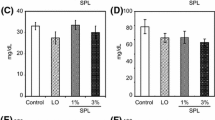Summary
We have studied the effects of Efamol evening primrose oil (EPO) on fatty acid-binding proteins (L-FABP) of rat liver. EPO contains 72% cis-linoleic acid and 9% cis-gamma linolenic acid. EPO has been clinically used for treatment of a number of diseases in humans and animals. EPO is also known to lower cholesterol level in humans and animals. Feeding of an EPO supplemented diet to rats (n = 9) for 2 months decreases the oleate binding capacity of purified L-FABP of rat liver whereas the palmitate binding activity was increased by 38%. However, EPO feeding did not alter the L-FABP concentrations significantly as measured by using the fluorescence fatty acid probe, dansylamino undecanoic acid. Endogenous fatty acid analysis of L-FABPs revealed significant qualititative and quantitative changes in fatty acid pattern after EPO feeding. EPO feeding decreased the endogenous palmitate level by 53% and oleate level by 64% in L-FABPs and also EPO feeding decreased the total endogenous fatty acid content from 62 nanomole per mg of protein to 42 nanomole per mg of L-FABP (n = 3).
Similar content being viewed by others
References
Horrobin DF, Manku MS: How do polyunsaturated fatty acids lower plasma cholesterol levels. Lipids 18: 558–562, 1983
Huang YS, Manku MS, Horrobin DF: The effects of dietary cholesterol in blood and liver polyunsaturated fatty acids and on plasma cholesterol in rat fed various types of fatty acids. Lipids 19: 664–672, 1984
Horrobin DF, Huang YS: The role of linoleic acid and its metabolites in the lowering of plasma cholesterol and the prevention of cardiovascular disease. Int J Cardiol 17: 241–255, 1987
Subbiah MTR, Dicke B: Effect of prostaglandin El and Fl on the activities of cholesteryl ester synthetase and cholesteryl ester hydrolase of pigeon aorta in vitro. Atherosclerosis 27: 107–111, 1977
Glatz JFC, Veerkamp JH: Intracellular fatty acid binding protein. Int J Biochem 17: 13–22, 1985
Ockner RK, Manning JA, Poppenhausen RB, Ho WKL: A binding protein for fatty acids in cytosol of intestinal mucosa, liver, myocardium, and other tissues. Science 177: 5658, 1972
Sweetser DA, Heuckeroth RO, Gordon GI: The metabolic significance of mamahan fatty acid-binding proteins: Abundant proteins in search of a function. An Rev Nutr 7: 337–359, 1978
Vincent SH, Muller-Eberhard U: A protein of the Z class of liver cytosolic proteins in the rat that preferentially binds heme. J Biol Chem 260: 14521–14528, 1985
Dutta-Roy AK, Goplaswamy N, Trulszch DV: Prostaglandin El binds to Z protein of rat liver. Eur J Biochem 162: 615–619, 1987
Raza H, Pongubala JR, Sorof S: Specific high affinity binding of lipoxygenase metabolites of arachidonic acid by liver fatty acid-binding protein. Biochem Biophys Res Commun 161: 448–455, 1989
Bassuk JA, Tsichlis PN, Sorof S: Liver fatty acid-binding protein is the mitosis associated polypeptide target of a carcinogen in rat hepatocytes. Proc Natl Acad Sci USA 84: 7547–7551, 1987
Ockner RK, Lysenko N, Manning JA, Monroe SE, Burnett DA: Sex steroid modulation of fatty acid utilization and fatty acid-binding protein concentration. J Clin Invest 65: 1013–1023, 1980
Bass NM, Manning JA, Ockner RK, Gordon GI, Seethram S, Alpers DH: Regulation and biosynthesis of two distinct fatty acid binding proteins in rat liver and intestine: Influence of sex difference and of clofibrate. J Biol Chem 260: 1432–1436, 1985
Renaud G, Foliot A, Infante R: Increased uptake of fatty acids by the isolated rat liver after raising the fatty acidbinding protein concentration with clofibrate. Biochem Biophys Res Commun 80: 327–334, 1978
Haq R-U, Shrago E: Dietary induction of rat liver fatty acid binding protein. Nutr Res 3: 329–333, 1983
Herzberg GR, Rogerson M: Role for fatty acid binding protein in the regulation of hepatic lipogenesis in dietary linoleic acid. Nutr Res 1: 601–607, 1981
Dutta-Roy AK, Trinh MV, Sullivan TF, Trulszch DV: Choline deficient diet increases Z protein concentration in rat liver. J Nutr 118: 1116–1119, 1988
Whitaker JR, Granum PE: An absolute method for protein determination based on difference in absorbance at 235 and 280 nm. Anal Biochem 109: 156–159, 1980
Bradford MM: A rapid method for the quantification of the microgram quantities of protein utilizing the principle of protein-dye binding. Anal Biochem 72: 248–254, 1976
Glatz JFC, Veerkamp JH: A radiochemical procedure for the assay of fatty acid binding by proteins. Anal Biochem 132: 89–95, 1983
Folch L, Lees M, Sloane-Stanely GH: A simple method for isolation and purification of total lipids from animal tissues. J Biol Chem 226: 497–509, 1957
Huang YS, Horrobin DF, Manku MS, Mitchell J, Ryan MA: Tissue phospholipid fatty acid composition in the diabetic rat. Lipids 19: 367–370, 1984
Catala A: Stearic acid desaturation in rat liver microsomes: stimulation by fatty acid binding protein. Acta Physiol Pharmacol Latinaum 36: 19–27, 1986
Glatz JFG, Jansen AM, Baerwaldt CCF, Veerkamp JH: Purification and characterization of fatty acid binding proteins from rat heart and liver. Biochim Biophys Acta 837: 57–66, 1985
Paulussen RA, Jansen GPM, Veerkamp JH: Fatty acid binding capacity of cytosolic proteins of various rat tissues: Effect of postnatal development, starvation, sex, clofibrate feeding, and light cycle. Biochim Biophys Acta 877: 342–349, 1986
Author information
Authors and Affiliations
Rights and permissions
About this article
Cite this article
Dutta-Roy, A.K., Demarco, A.C., Raha, S.K. et al. Effects of linoleic and gamma-linolenic acids (efamol evening primrose oil) on fatty acid-binding proteins of rat liver. Mol Cell Biochem 98, 177–182 (1990). https://doi.org/10.1007/BF00231382
Issue Date:
DOI: https://doi.org/10.1007/BF00231382




